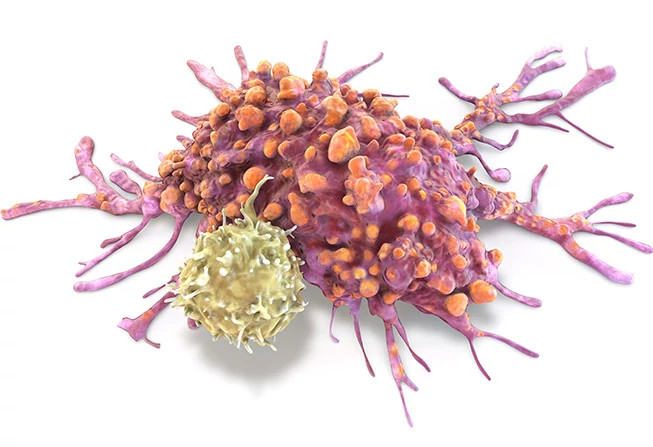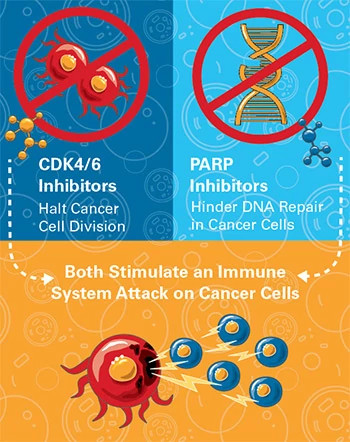Unexpected Benefits From Targeted Therapy
How CDK4/6 and PARP Inhibitors Work Together in Targeting Disease
By Robert Levy

Serendipity is rarely sweeter than when it occurs in cancer research. In a field where progress is hard-won, where success often comes in increments rather than wholesale leaps, it's particularly rare for a new treatment to not only work as intended but also to possess powers that developers hadn't expected.
Yet that is precisely what Dana-Farber researchers recently discovered about two of the most effective types of targeted therapies — CDK4/6 inhibitors and PARP inhibitors — to arrive in recent years. The twin findings, announced within months of each other, show that in addition to having their known effects in tumor cells, the agents also can stimulate the immune system to fight cancer. The findings suggest that, effective as the drugs are on their own, they could be even more potent when combined with agents that release barriers to the immune response.
Together, the discoveries suggest that many targeted therapies — usually thought to wage a narrow-gauge attack on cancer cells — may do double duty as immunotherapies.
Alternate Tracks
PARP inhibitors and CDK4/6 inhibitors target cancer cells by two very different routes.
CDK4/6 inhibitors, which have a long pedigree in Dana-Farber research, deprive cancer cells of their most notorious characteristic: their ability to divide endlessly. They work by blocking enzymes needed to pass from one phase of the cell cycle to the next. The result is something very un-cancerlike — a tumor cell that simply vegetates, that survives without growing or proliferating.
The drugs showed promise from the time they entered clinical trials. They were first approved by the Food and Drug Administration (FDA) in 2015 for patients with the most common subtype of breast cancer (hormone receptor-positive breast cancer) and are currently being tested, with encouraging results, in a variety of other cancers.

"In early trials of these drugs, we noticed that in some breast cancer patients the tumors didn't just remain the same size — as would be expected with drugs that interfere with cell division — but began to recede, sometimes quite dramatically," said Dana-Farber's Shom Goel, MD, PhD.
The reason for the shrinkage, scientists at Dana-Farber and Brigham and Women's Hospital (BWH) found, lay outside the cell division machinery itself, in the cancer's always delicate relationship with the immune system.
Leading the research with Goel were Hye-Jung Kim, PhD, working in the laboratory of Jean Zhao, PhD, of Dana-Farber and the Broad Institute of MIT and Harvard, and Molly DeCristo, a Harvard Medical School graduate student in the laboratory of Sandra McAllister, PhD, at BWH.
To understand why the tumors sometimes shrank, the investigators examined how the CDK4/6 inhibitor abemaciclib acted in animal models of breast or other solid tumors. They found it not only stalled the tumor cycle but also caused the immune system to mount an attack on the tumors — a finding they confirmed by analyzing tissue samples from women in a clinical trial of a CDK4/6 inhibitor for breast cancer.
The drugs trigger an anti-tumor immune response in two ways, the researchers reported in Nature. They prompt tumor cells to reveal their malignant nature by decking themselves in abnormal proteins called neoantigens. The immune system, incited by this display, responds by attacking the tumor cells.
At the same time, the drugs cause the number of "T regulatory cells," or Tregs, to diminish. These cells, the cousins of the better known "killer" T cells, exert a sedating effect on the immune response to disease or infection. With fewer Tregs in circulation, the immune response intensifies. Taken together, these two processes have the ability to halt or even reverse tumor growth.
Within a few months of the publication of these findings, two other research teams including Dana-Farber scientists published papers that found additional connections between CDK4/6 inhibitors and the immune response. One showed that the drugs cause tumor cells to sprout additional PD-L1 proteins on their surface.
These proteins ordinarily allow tumor cells to derail an immune attack, suggesting that combining CDK4/6 inhibitors with drugs that foil PD-L1 could leave tumors especially vulnerable to the immune response. The second paper showed that CDK4/6 inhibitors also "activate" immune system T cells, putting them in attack mode against cancer cells.

Picking at a Sore
PARP inhibitors, the second category of targeted drugs with an immune-stimulating side, work by taking a common vulnerability in cancer cells and aggravating it even further.
The existence of a cancer cell can be a precarious proposition. For all its rowdy growth and brash behavior, a tumor cell may be struggling to repair damage to its DNA, an activity critical to its continued survival. Mutations or other genetic abnormalities can disable proteins involved in making such repairs. As the damage mounts, the cell's ability to function — dependent on the instructions encoded in its DNA — diminishes, potentially to the point where it can no longer sustain itself.
PARP inhibitors take advantage of this weakness by administering a finishing blow to cancer cells. Cells with mutations in the BRCA genes, for example, have trouble repairing breaks that occur in both strands of the DNA molecule. They compensate, in part, by relying on genes that mend breaks in one strand. PARP inhibitors work by crippling some of those single-strand specialists. Already coping with the loss of two-strand repair genes, the cells are ready prey for drugs that shut down the single-strand repair machinery.
PARP inhibitors have been approved for patients with breast or ovarian cancer who have inherited mutations in the BRCA genes, as well as for some patients with recurrent ovarian, fallopian tube, or peritoneal cancer that responds to platinum-based chemotherapy, and are in clinical trials for a range of other cancers.
"In each of these cancers, the consensus was that the drugs' effectiveness was due to the direct killing of cancer cells," says Jean Zhao, PhD, of Dana-Farber and the Broad Institute, who led some of the recent research into PARP inhibitors. "We've shown that in the case of ovarian cancer, another factor is at play — the effects of the drugs on the interaction of tumor cells with the immune system."
In recent years, it's become clear that the immune system responds to DNA damage in tumor cells by dispatching powerful agents, including T cells and interferon (proteins that intensify the immune response) to the site of the tumor. This immunological show of force was thought to pose little threat to the tumor cells; it was mainly viewed as a response to the die-off of tumor cells triggered by PARP inhibitors. Zhao and her colleagues wanted to determine if that was truly the case.
To assist in this effort, Liya Ding, PhD, a research fellow in Zhao's lab, created animal models of high-grade serous ovarian cancer (HGSOC), the most common form of ovarian cancer, that closely resembled HGSOC in humans. One set of models had a normal complement of the BRCA1 gene, the other lacked the gene.
In the models without normal BRCA1, researchers found that PARP inhibitors sparked an immune response that inundated the tumors with T cells and other immune system agents. "We then asked whether the immune response was meaningful. That is, does it actively contribute to inhibiting tumor growth or is it primarily a passive response to the death of tumor cells?" Zhao remarks.
In a series of experiments, they demonstrated that it is overwhelmingly the former. In one, they disabled T cells known as CD8+ T cells — which directly attack tumor cells — after the animals had been treated with a PARP inhibitor. The result was a regrowth of the ovarian tumors — evidence that CD8+ T cells were active participants in the assault on cancer cells. This finding, coupled with further research, provided convincing evidence that the immune response to PARP inhibitors is more than just a mop-up crew for dead cancer cells but a partner in causing their death.
Because BRCA1-deficient HGSOC tumors tend to wear a thicker coat of PD-L1 proteins after treatment with a PARP inhibitor, Zhao's team theorized that pairing the drugs with checkpoint inhibitors would be even more effective. Experimental results bore that out: investigators found that mice treated with a PARP inhibitor-checkpoint inhibitor combination lived longer than those treated with the PARP inhibitor alone.
"These findings have important implications for the treatment of ovarian cancer," said Ursula Matulonis, MD, director of Gynecologic Oncology in the Susan F. Smith Center for Women's Cancers at Dana-Farber and a co-leader of the research. "When used in conjunction with other agents such as PD-1 inhibitors, PARP inhibitors can have enhanced anti-cancer activity, and we now know why. The findings add new impetus to clinical trials testing this combination."
Many researchers believe that PARP inhibitors and CDK4/6 inhibitors are not the only agents to have a pleasant immunological surprise. Future studies will reveal if there are others.
Other Feature Stories from Paths of Progress 2020
-
A Case for Curiosity
Tracing the circuitous path that led to the 2019 Nobel Prize in Physiology or Medicine for Dana-Farber's William Kaelin Jr., MD.
-
Shapeshifters in the Brain
Understanding how aggressive brain tumors evade treatment with new technology that examines genetic information within individual cells, one at a time.
-
Bringing AI to Personalized Cancer Care
Machine language technology brings the new capability to study each individual's risks and best treatment options.
-
Liquid Biopsies Move Toward the Clinic
Chemical biologists create small molecules to boost discoveries and prototype novel therapies.
To see the entire publication, please download the PDF version.
Request a Publication
Receive by mail the current issue of a Dana-Farber publication by completing this request form.
Media Contacts
If you are a journalist and have a question about any of our stories or need more information, email media@dfci.harvard.edu or call 617-632-4090 and ask to speak to a member of the media team.
The Media Team cannot respond to patient inquiries. For more information on contacting Dana-Farber, please see Contact Us.
Disclosure of Advisory Roles and Certain Industry Support
See an overview of relevant board memberships, outside support, and significant advisory roles as reported by several physicians and researchers featured in the 2020 issue of Dana-Farber's Paths of Progress magazine.